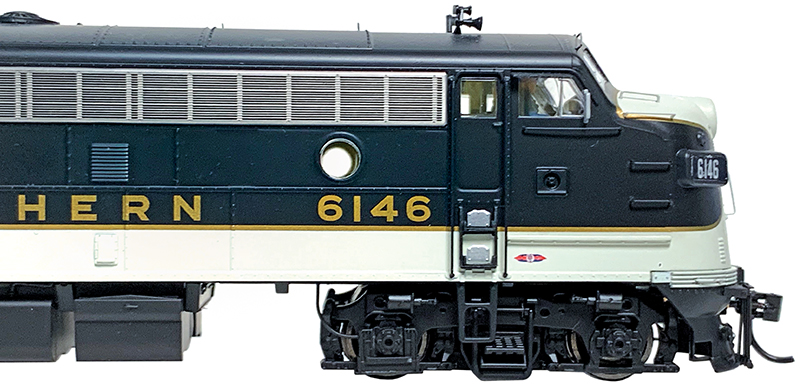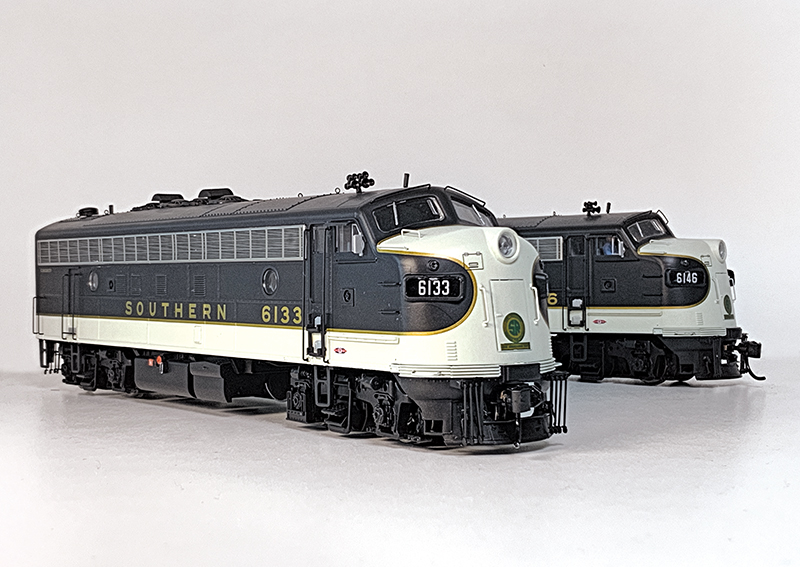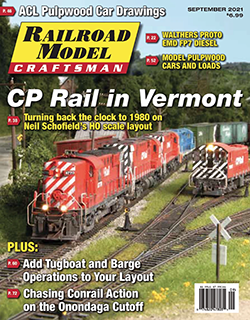 Review by Harry K. Wong/photos by the author
Review by Harry K. Wong/photos by the author
In the early days of converting premium passenger trains from steam to diesel propulsion during the 1940s, those railroads that sourced their new diesel locomotives from Electro-Motive had two basic passenger locomotive configurations to choose from; either a six-axle 2,000hp dual-prime mover E-series locomotive, or a four-axle 1,500hp F3/F7-series locomotive.
Regardless of the number of physical axles, only four traction motors could be provided in either configuration, resulting in either an A1A-A1A or B-B wheel arrangement. Typically, train assignments with mountainous grades favored F-series locomotives, while the E-units performed best on flatter routes. Back then, a key requirement for passenger locomotives was to provide steam heat to power air conditioning and heating systems in the passenger cars.
As a result, most diesel locomotives regularly assigned to passenger service were equipped with boilers, aka steam generators, to address this need. Depending upon the length of the train, these passenger units were often found in multiple-unit A-A, A-B-B-A, or in five-unit combinations or even larger where appropriate.
Those railroads that assigned boiler-equipped F-units to passenger service soon found out that four-axle EMD A-units equipped with dynamic brakes lacked the room for water tanks of a capacity equivalent to that carried in the trailing booster units, creating a situation where the steam generators in the A-units would run out of water faster than in the booster units. Cabless booster units such as the F3B or F7B had the extra room not being used by a crew cab for a large water tank to supply the steam generator onboard.
Roads such as Santa Fe worked around the problem by equipping their F7A units with only the controls for steam generators in the trailing booster units, but no steam generator in their F7As assigned to passenger service. The Northern Pacific chose to add extra water tanks in a trailing baggage car to supply water to their A-units.
EMD’s solution to this problem was to add an extra four feet of length behind the cab of an otherwise standard F-unit to accommodate larger water tanks to supply the steam generator on board. The first production version of this solution became known as the FP7. The extra length of an FP7 can be seen between the first porthole behind the cab and the first louver set of the engine compartment.
Produced between June 1949 and December 1953, a total of 324 FP7s were constructed by EMD in La Grange, Illinois, with an additional 57 units built in Canada by EMD’s Canadian counterpart General Motors Diesel (GMD).
Contrary to some misconceptions, it is important to note that while matching booster units were often ordered in conjunction with FP7s, as far as EMD’s official terminology was concerned, there is no such thing as an “FP7B” or “FP9B,” but instead only steam-generator equipped F7Bs and F9Bs. This is because boiler-equipped F7Bs and F9Bs already had all the room they needed for sufficient water-carrying capacity, and, aside from the steam generator, water tanks and piping, did not differ much otherwise from their freight-hauling F7B/F9B brethren. However, Individual railroads sometimes had their own internal terminology for boiler-equipped F7Bs and F9Bs.

The side profile of WalthersProto FP7 painted for the Southern Railway.
As part of their latest release of EMD FP7s to their premium WalthersProto line, Walthers is offering their FP7 finished in the colors of Southern Railway and for a number of other operators including Amtrak and Southern Pacific. Our review samples come from a boxed set of two sound-equipped FP7s decorated to represent Southern Railway FP7s 6133 and 6146.
After purchasing many EMD E6s and E7s, along with Alco DL-109s and PAs for passenger service, Southern Railway received 20 FP7s in the early 1950s to be assigned to their shorter trains such as the Piedmont Limited, Asheville Special, and Pelican. Many of these shorter passenger trains operated over mountainous territory, which was better suited for the FP7s over the E units.
Southern chose not to join Amtrak in 1971, opting instead to operate its own passenger trains. However, as only four passenger trains remained in operation on the SR, the FP7s were released to freight service on many occasions. When SDP40Fs were temporarily banned from the rails of the Burlington Northern, Amtrak even borrowed several Southern FP7s including 6143, 6146 and 6147 for service on Amtrak’s Coast Starlight over BN’s rails between Portland and Seattle in 1977. When Southern finally joined Amtrak in 1979, 15 of the FP7s were scrapped, retaining five for service on executive trains. Today, these five units still survive in preservation at several locations throughout the southeastern United States.
While Southern’s FP7s were first delivered in the green-and-white passenger service version of the “Tuxedo” paint scheme, they were later repainted into a variation of the black, white and imitation gold version that first appeared on freight units. Confusingly, about six of the 20 Southern FP7s along with a few E8s were repainted from black-and-white “Tuxedo” back to green-and-white “Tuxedo” in 1972 to further differentiate Southern’s own separate passenger services from the newly formed Amtrak of the period.
The Walthers FP7s for this release are finished in the black, white, and gold version of the “Tuxedo” scheme, with the “Look Ahead, Look South” slogan appropriate for units beginning in 1968.
As is now customary of WalthersProto series models, a long list of road-specific details are provided on this premium-level offering. Looking beyond the black “Tuxedo,” details appropriate for SR FP7s up top include: a blanked access panel where the dynamic brake fan would rest on other roads, followed by four 36-inch cap-top radiator fans, dual exhaust stacks capped by Southern-style rectangular “screened” spark arrestor assemblies, a set of cooling coils, and, at the far end of the locomotive, piping, round vents, and an exhaust port for the steam generator. Up front, the cab roof features prototypically-accurate details including a simulated “firecracker”-style radio antenna and a finely cast metal Nathan M5 horn cluster with all bells facing forward.

The front and rear of the Southern FP7.
A painted cab interior, engineer and fireman figures are provided. The side windows on the cab come equipped with vertical mirrors positioned ahead of the cab sunshade. Oddly, the windshield wipers are molded onto the clear plastic front windshield panes — this is a bit of an anachronism for this otherwise premium-level locomotive offering. Separately applied and painted metal grab irons and vertical handrails are mounted in the proper standard and road-specific locations throughout the body shell. The photoetched metal side grilles are perfectly applied and sit laser-straight on each of our examples.
Notable era-specific details appropriate for these FP7s include m.u. hose clusters on the front pilot, and a printed outline meant to represent the high-mounted m.u. receptacle cover adjacent to the front headlight. Our Southern Railway FP7s also feature speed recorder details with a cable on the no. 1 axle on the fireman’s side and an Automatic Train Stop (ATS) shoe with cable beneath the no. 2 axle journal on the engineer’s side.
Finely executed tiny metal lift rings at the corners of each access panel add that final bit of extra detail atop the roof of these FP7s. The rear of the locomotive features m.u. hoses, a flexible coupler lift bar and an operational single-beam rear headlight. Other schemes also feature road-specific details commensurate with their paint schemes. For example, the former SP units transferred to Amtrak feature large pilot plows, rooftop-mounted icicle breakers, simulated oscillating Gyralites and a host of other details as appropriate.
On the Walthers FP7s we have observed, paint coverage is even and opaque without obscuring details. All lettering and markings are crisply applied with accurate registration and opaque throughout…




